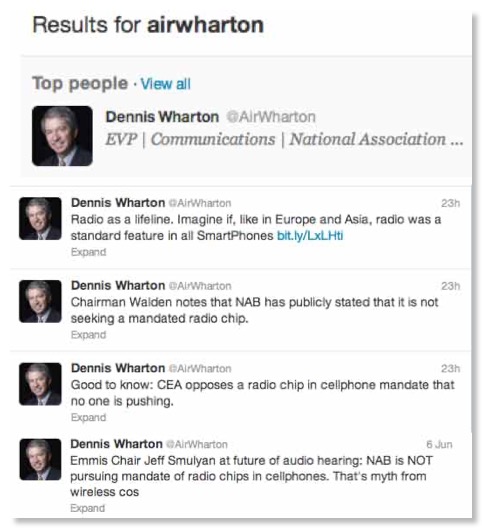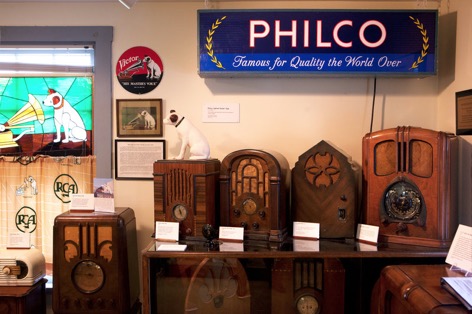NAB's Campaign for FM in Cellphones: Possible Unintended Side Effects

In any case this legislation never gained any traction.
Recently, NAB-related Twitter feeds have been gloating about "voluntary" agreements with cellular carriers to "unlock" the FM demodulator in most or possibly all Android smartphones.
Momentum Grows for FM #Radio in Smartphones | @NAB_Labs http://t.co/4plT8RsFMw
— Jacobs Media (@jacobsmedia) August 25, 2015T-Mobile, AT&T and Sprint back FM chips in cellphones. We (& FEMA's Craig Fugate) welcome Verizon to join the party http://t.co/5ooCmpSS37
— Dennis Wharton (@AirWharton) August 19, 2015In view of the bizarre deal NAB allegedly tried to cut with the record industry on this issue, one wonders what NAB might have offered these cellular carriers? Support for their opposition to net neutrality? Support for their implementation of LTE-U in Wi-Fi bands? (Note that NCTA is strongly against this so supporting it could get back at 2 NAB enemies at the same time!)
Just as this issue is getting resolved bilaterally between the broadcasters and the cellular carriers, there was a piece today on NAB member NBCUniversal's Today Show about the danger from "ear buds" typically used with smartphones. Here is a quote:
"Probably the largest cause [of hearing damage] is millennials using iPods and [smartphones]," says Dr. Sreekant Cherukuri, an ear, nose, and throat specialist from Munster, Indiana. Hearing loss among today's teens is about 30 percent higher than in the 1980s and 1990s, Cherukuri estimates….Cherukuri tells young patients to stop wearing headphones — especially earbuds, which place the sound closer to the ear drum, enhancing volume by as much as 9 decibels. "
Yes, ear buds came with cellphones to be used for voice calls. But the number of minutes of voice calls per phone is not increasing as most millennial prefer texting or e-mail. (Some that is also helpful in the RF safety area.) But encouraging millennials to use their ubiquitous smart phones for long term FM music listening just as the Sony Walkman disappears could raise the very issues that Dr. Cherukuri raises above as an unintended consequence. There are smartphone apps that limit acoustic power to prevent this danger, but we don't see much from either NAB or the cellular industry on why this is important for millennials.
Yes. the Walkman had a similar problem, but they were generally used with headphones not today's ear buds. The website, TeensHealth is the source of the green infographic at the right. It clearly says "Noise-induced hearing loss due to earbuds is 100% preventable if you use them in moderation." If the broadcast industry is so intent on changing the life style of millennials, we hope that pay attention to this key health issue also.
NAB and the FM in Cellphone Issue: The Disappearance of Radios

The National Capital Radio and Television Museum in Bowie, Md., is home to radios dating back to the 1920s
Photo from NPR.
Today is World Radio Day, a joint venture of ITU and UNESCO. UNESCO says
World Radio Day is about celebrating radio, why we love it and why we need it today more than ever. A day to remember the unique power of radio to touch lives and bring people together across every corner of the globe. Join the celebration!…Radio is a medium for the future. It has a duty to include young people, not just as listeners but as active producers and creators of content…In conflict and disaster zones, young international freelancers and local fixers contribute invaluably to the pursuit of information. They deserve to work in safety and security. Find out what can be done.
To celebrate this event, NPR had a piece this morning on “Finding A 'Radio That Is Just A Radio' In The Digital Age”. They sent their intrepid reporter out to buy “just a radio” - by which they meant a battery powered radio with a speaker but without a CD player, internet connection, etc. Good news is they found a convenient source even though the big box stores had nothing. Bad news is that source was Radio Shack! (However, they found alternatives available over the net.)
But this got me thinking about NAB’s past efforts in promoting HDRadio and in a statutory mandate for cell phones to include FM receivers. Earlier NAB blamed FCC for the failure of AM stereo since FCC did not immediately agree with NAB’s view of picking a technical standard. Of course, they conveniently ignore that AM stereo fizzled in other countries where the regulators kowtowed to the broadcasters and promptly picked a single standard. Just because we can build technology X does not necessarily mean that consumers want technology X.
So NAB Labs continues to discuss the availability of FM receive capability in smartphones, NAB provides a website radiorocksmyphone.com with this viewpoint:
Now, many Americans are demanding a FREE entertainment option as a feature on their smartphones – local radio! It's been around for decades, but it's better than ever – more music, more news, more choices than ever before. And best of all, it doesn't require a broadband connection or eat up your data plan.
The site has a list of “Radio Ready Cell Phones”: mostly from HTC, with a refurbished Blackberry, an Alcatel model, 2 models from LG and 3 from Samsung. (The list was last updated in June 2014 so maybe NAB isn’t taking this too seriously.)
I like radio, but I am a baby boomer not a “millennial”. Heck, I even have a ham radio license! I support NPR with donations and listening. But the way to keep radio from fading away is not to force consumers to buy a product they clearly are losing interest in; the way to preserve it is to have it carry content that people really want.




![Validate my RSS feed [Valid RSS]](valid-rss-rogers.png)

